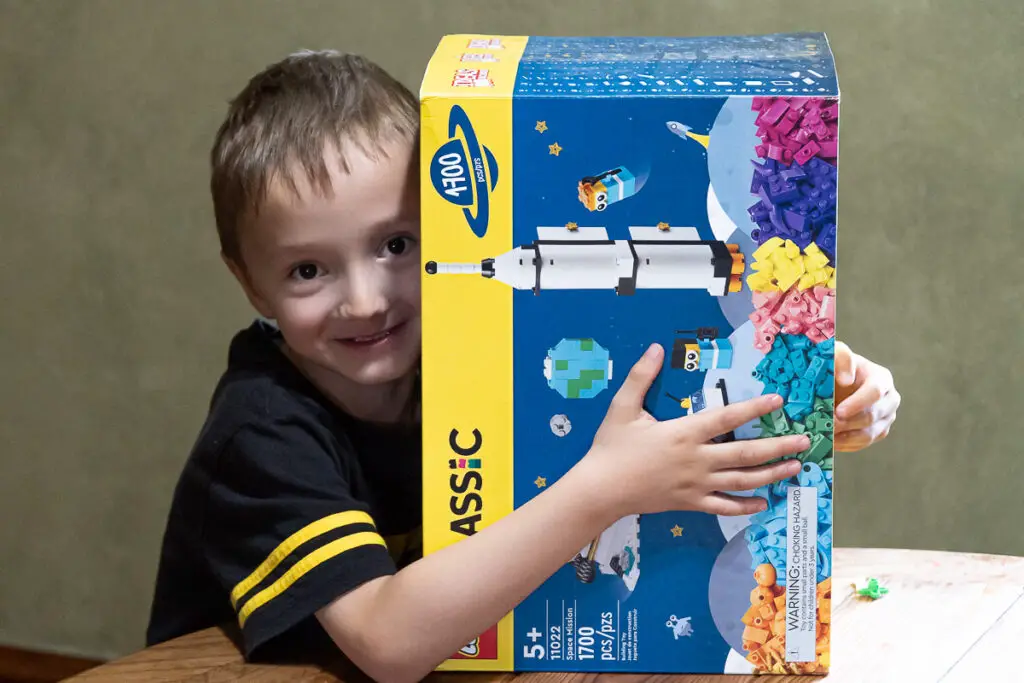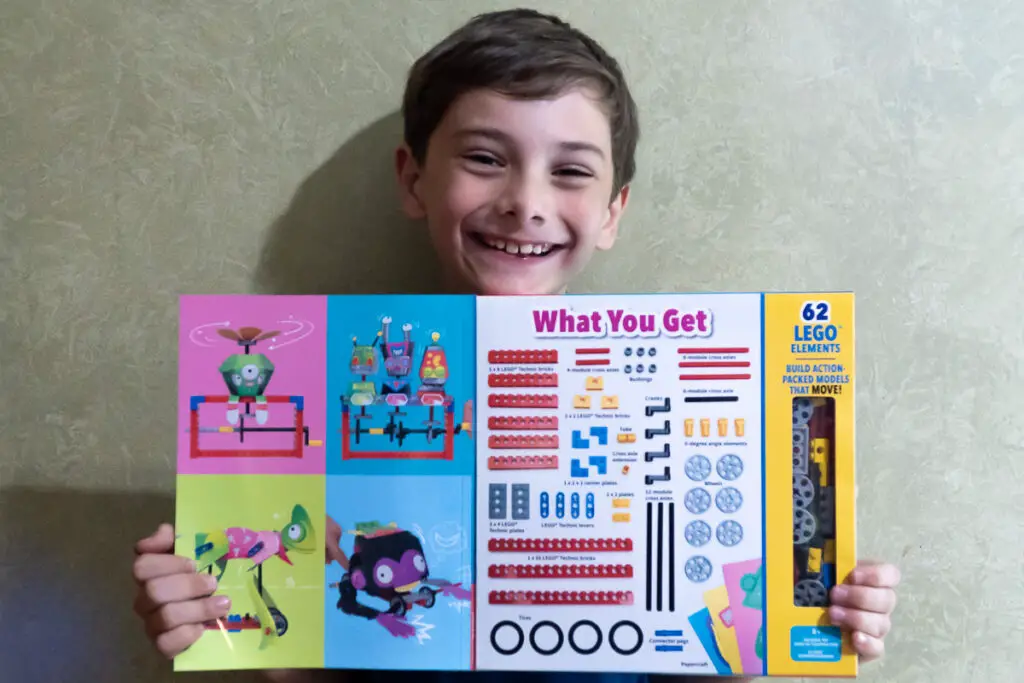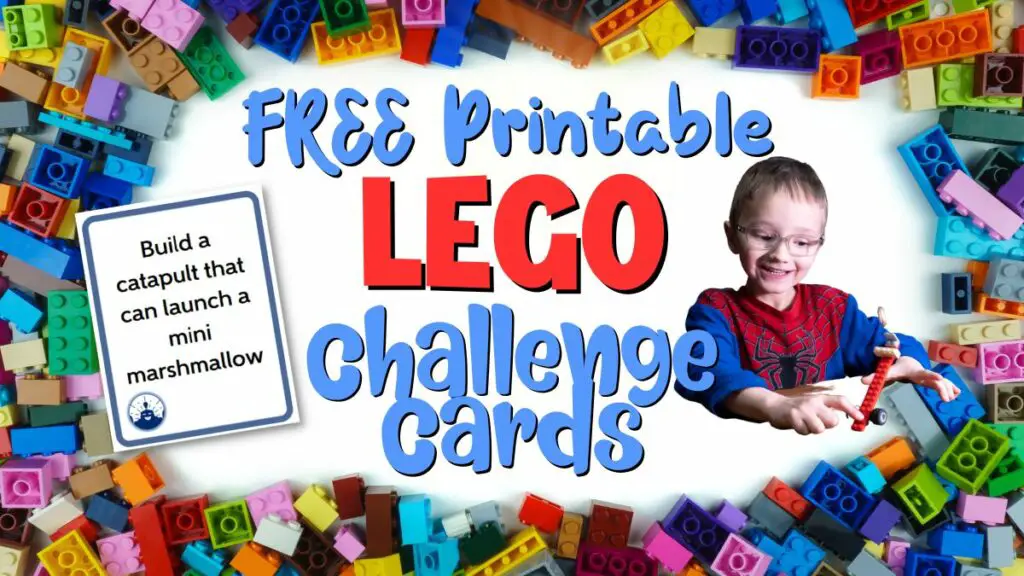LEGO bricks are hands down our children’s favorite toy, and (whether they realize it or not) they’re learning every time they play – especially when we give them some direction and building challenges. Combining LEGO and STEM creates fun and educational activities for children.
LEGO activities can help kids learn STEM concepts while having fun. Children can start with simple activities such as building towers and bridges using LEGO bricks to develop fine motor skills. Older children can tackle more difficult activities such as engineering challenges or basic coding activities.
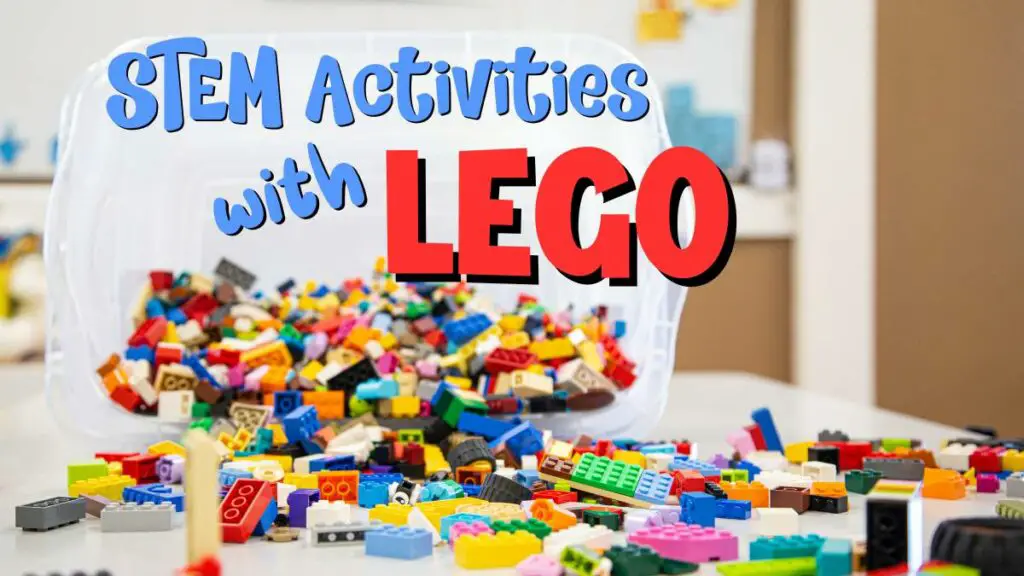
*We’re an affiliate – we may earn a commission through qualifying purchases from the links on this page. As always, thanks!*
LEGO activities can be used for different age groups, from pre-kindergarten children to elementary school students. Younger children can use LEGO blocks to learn about shapes, colors, and counting and can grow to learn about simple machines, engineering challenges, and science experiments.
These activities can be done at home or in a classroom setting. Kids can do them alone, play along with you, use them as team building exercises, or add a bit of competitive edge to the challenges.
However you do them, LEGO STEM activities are a great way to keep children entertained while learning new skills. By using LEGO, children enhance their creativity and problem-solving skills as they use their cognitive abilities to build complex structures.
Though you’ll find LEGOs in the toy isle, they’re a valuable resource for teaching STEM concepts to children of all ages. LEGO STEM activities are fun and educational, allowing children to learn new skills while having fun at the same time. Let’s explore!
LEGOs for STEM Projects
Before we get ahead of ourselves, we’ll need some LEGOs. Lego sets are great and offer learning opportunities (following directions, spatial reasoning, etc.), but you can also go a long way with just a box of plastic bricks.
Here’s our current favorite set of LEGO bricks: It includes 1700 pieces with directions for some vintage space set builds. I was surprised our kids just dumped out the box and started building stuff, letting curiosity and creativity guide them (and it was so much fun I had to join in.)
If you want something more structured, LEGO offers “Klutz” sets that are specifically STEM branded like this Gear Bots set. There are different sized gears and mechanisms to build simple machines. There are directions for 8 different configurations. The boys loved the monkey, and I thought the chameleon was interesting.
Whether you opt for a set with instructions or just go wild with a bucket of bricks, there are tons of activities for kids (and adults) with a focus on STEM concepts.
Types Of LEGO STEM Activities
LEGO STEM activities offer a hands-on way for children to learn about science, technology, engineering, and math concepts. These activities are not only fun, but they also help build children’s creativity and problem-solving skills. There are different types of LEGO STEM activities that can be done at home or in a classroom setting which cater to different age groups.
LEGO Building Challenges
One type of challenge is the bridge-building challenge, where kids can learn how to construct a bridge using LEGO bricks. This challenge teaches them about structural engineering, balance, and stability. You can set a simple challenge, like “build a bridge that spans the gap between 2 stacks of books” or a certain distance. You can get a bit more complex by adding weight requirements of how much the bridge needs to hold.
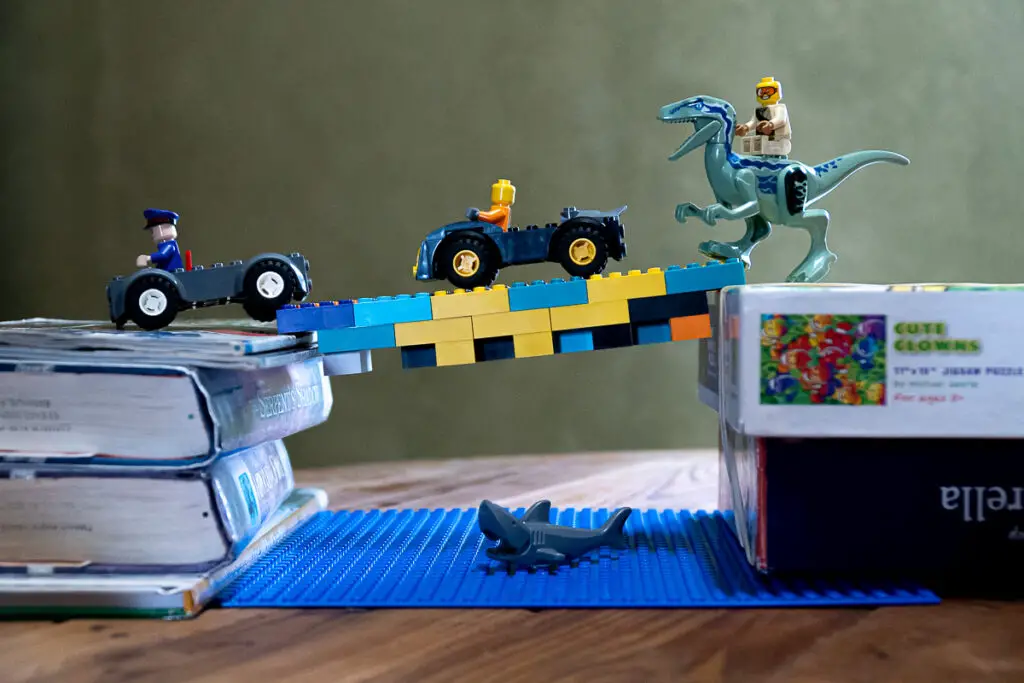
You can also make a game out of it to learn a bit about structure and engineering. Take turns removing a piece from your bridge, and see who collapses the bridge. You’ll need to be strategic trying to judge which pieces are important to structural integrity.
For more bridge building inspiration, experiment with different shapes, materials, and designs to see which ones hold the most weight. Up the challenge level by limiting the number or types of pieces, or the length the bridge needs to span.
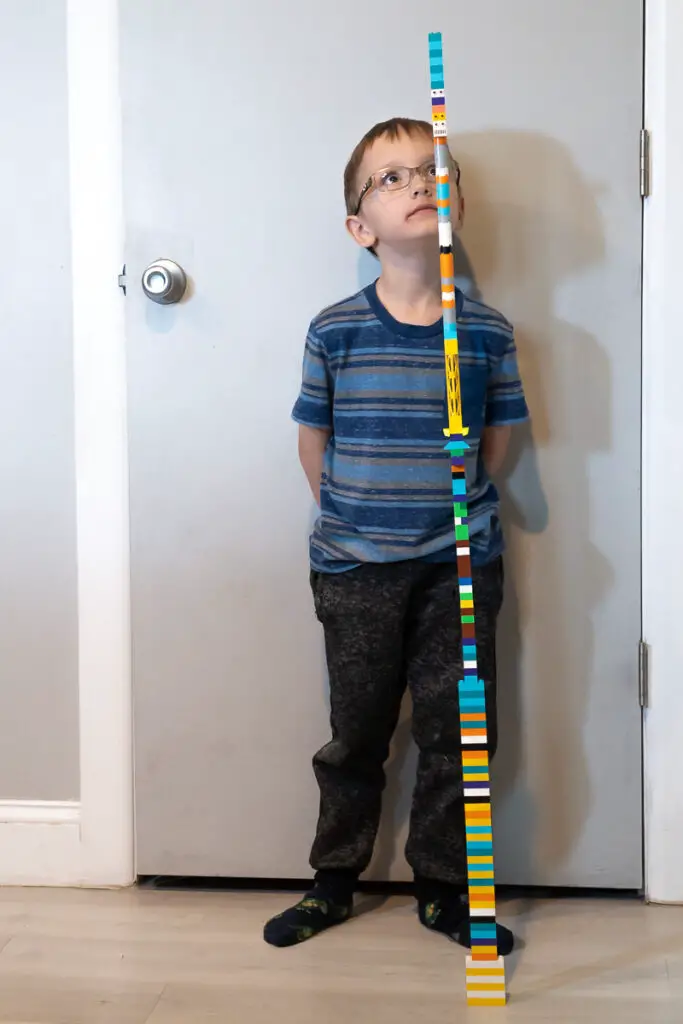
Another fun build kids love is the tallest tower challenge, where children compete to create the tallest LEGO tower possible (and it’s perfectly fine to compete with yourself at home.) You can have some fun by changing the parameters of the challenge, like “make your tower symmetrical,” or see who can build a tower that can withstand a hit from a catapult.
Speaking of catapults, building a simple machine is another fun LEGO challenge. You can check our post on building catapults for kids for a few LEGO catapult designs. The Gear Bots set we mentioned earlier has some great examples of simple machines.
These challenges can be as simple or complex as desired, depending on the age and skill level of the kids.
Basic Math Concepts Using LEGOs
LEGO bricks are not just for building fun structures, but they can also be used as an excellent tool for teaching basic math concepts to children. LEGO math activities are a great way to introduce math concepts in an interactive and engaging way. Here are some ideas for using LEGO bricks to teach basic math:
Building Number Lines – Number lines are a great way to help children understand addition and subtraction concepts. Using LEGO bricks, you can create a number line by simply placing different colored bricks in a line and labeling them with numbers. Children can then use the number line to practice addition and subtraction problems.
Equations and Problem Solving – Using LEGO bricks, you can also create equations and solve math problems. For example, you can use different colored bricks to represent numbers, and then use them to build equations. Children can also use LEGO bricks to solve math problems by manipulating the bricks to represent the problem.
Visual Aids for Mass and Weight Concepts – LEGO bricks can also be used as visual aids to help children understand concepts such as mass and weight. For example, you can use bricks of different sizes and weights to demonstrate the concept of mass. Children can also use the bricks to compare the weight of different objects.
Symmetry and Patterns – LEGO bricks can also be used to teach symmetry and patterns in math. Children can use the bricks to create different patterns and shapes, and then explore the concept of symmetry by examining the patterns they have created.
To go more in depth, check out our full post detailing how LEGO math activities are a fun and effective way to introduce children to basic math concepts. And be sure to check out our post on how to make math fun for more ideas.
Science Experiments With LEGOs
Science experiments with LEGOs are an exciting way to teach children about various scientific principles while making learning fun. Below are some experiments that children can conduct using LEGOs.
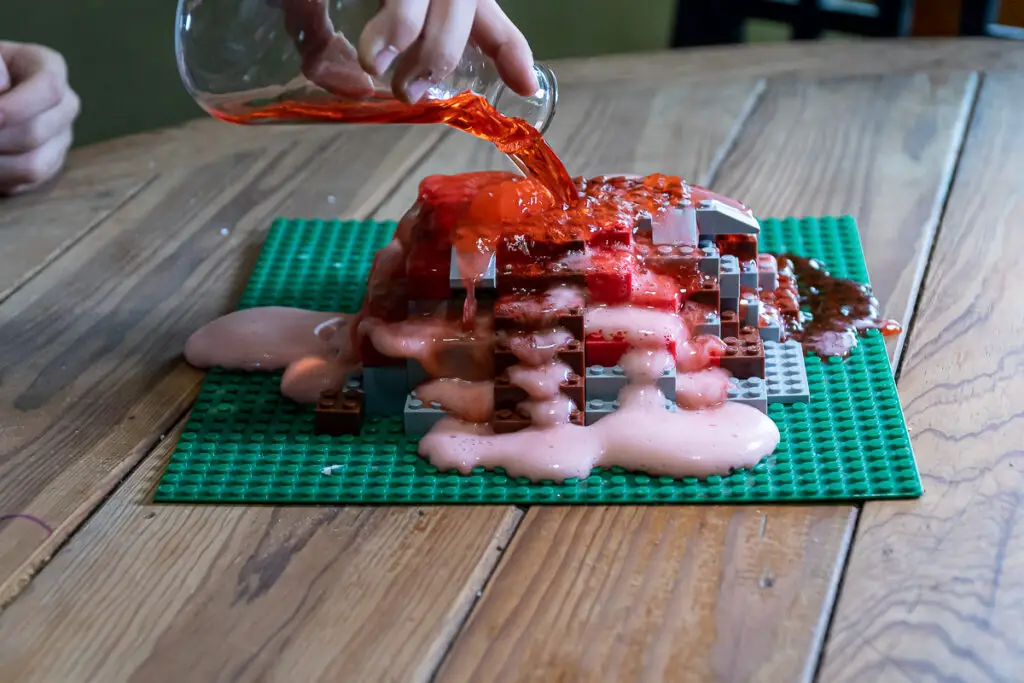
One popular experiment is creating a LEGO volcano that actually erupts. To do this, build a volcano using LEGO bricks and then add baking soda, red food coloring, and vinegar to create an eruption. This experiment helps demonstrate chemical reactions and the formation of volcanoes in a hands-on way. Read this post to learn more about the chemical reaction and building a LEGO volcano.
Another idea is to design a fidget spinner using LEGOs to learn about physics. Children can experiment with different designs and weight distributions to create a spinner that spins for longer. This activity teaches children about the principles of rotational motion and physics concepts like torque, balance, and speed.
Water Cycle Activity With LEGOs
You can also make dioramas to illustrate science concepts, like the water cycle. With the help of LEGO pieces, children can easily build a model of the water cycle and visualize each stage of its process. Use your imagination and brainstorm for science project ideas that can be done using LEGO. Here’s how we built a quick Water Cycle Illustration with LEGO:
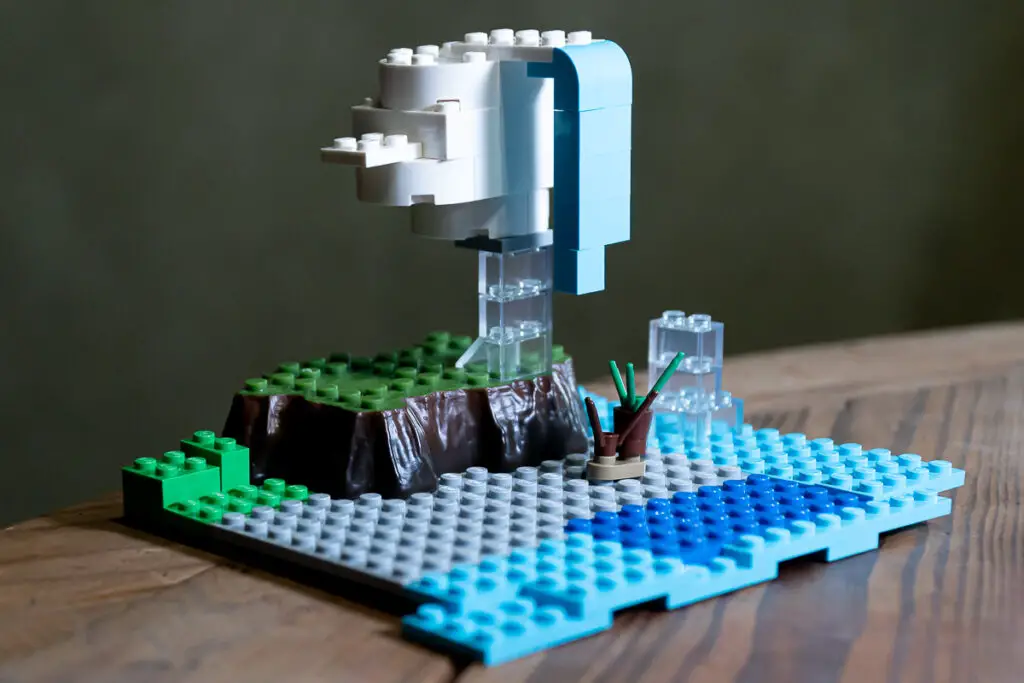
To start, you will need the following LEGO pieces:
- Blue LEGO pieces (to represent water)
- Transparent LEGO pieces (to represent gas or water vapor)
- Brown LEGO pieces (to represent soil or land)
- Gray LEGO Pieces (to represent rock or stone)
- Green LEGO pieces (to represent vegetation)
- White LEGO pieces (if you want to make a cloud)
Once you have the necessary LEGO pieces, follow these simple steps to create your model of the water cycle:
1. Build a small pond using the blue LEGO pieces.
2. Build a mountain next to the pond using the brown and/or gray LEGO pieces.
3. Add the transparent LEGO pieces on top of the pond to represent water vapor.
4. Use the green LEGO pieces to add vegetation around the pond.
5. Place a transparent LEGO piece on top of the mountain to represent the process of evaporation.
6. Finally, add another blue LEGO piece on top of the transparent piece to represent condensation. This will simulate the process of water vapor turning back into liquid.
This can be a simple build that illustrates how the sun’s energy causes water to evaporate, how it forms clouds in the sky, and how it falls back to the earth as either rain or snow. This simple model will help your child visualize the complex processes of the water cycle and understand its importance.
For another take on this, here’s a cute stop motion video using LEGO to explain the water cycle:
LEGO Challenge Cards
If you’re looking for a fun and engaging way to encourage kids to participate in STEM activities, LEGO challenge cards are a creative and interactive option worth considering. These cards provide prompts to build something using LEGO bricks.
One of the best things about LEGO challenge cards is that they can be used in a variety of settings. Teachers can incorporate them into their classroom activities as a hands-on way to teach physics, engineering, and mathematics concepts. Summer camps can use them to encourage teamwork and collaboration amongst the campers. Parents can even use them as a fun birthday party activity or a rainy-day activity at home.
Stuck for an idea of something to build? – grab a challenge card. Are the kids bored? grab a challenge card. Need an idea for a class activity, competition, or team building skill? You guessed it – grab a challenge card. Don’t know where to get a challenge card? We’ve got you covered – check out our Free LEGO Challenge Cards.
Storytime LEGO Building Challenge
The Storytime LEGO Building Challenge is a fun and educational activity that combines literacy and engineering concepts to expand children’s learning opportunities. With open ended building challenges, kids can develop their logic skills and appreciation for reading while also practicing their engineering and design skills.
By including storytime in the LEGO building challenge, kids are encouraged to use their imaginations to bring their favorite characters and stories to life. This not only enhances their creativity but also promotes a love for reading.
To make the most of this activity, it’s important to combine literacy and engineering concepts. This may take a bit of thought, and can be done by choosing a story that has characters or structures that can be built with LEGOs. Children can then work to build their own interpretations of these characters and structures.
They don’t have to be complicated or too involved. Here are a few ideas to get started:
- Build a LEGO version of Wall-E.
- Build the Batmobile
- Build a house from the Three Little Pigs
Motor Skills Challenges using LEGO
Motor skills challenges using LEGO are an excellent way to engage children in hands-on learning while improving their hand-eye coordination, dexterity, and fine motor skills. These challenges are not only fun but also help in developing children’s cognitive abilities and problem-solving skills.
One of the exciting motor skills challenges with LEGO is building towers using only one hand. This challenge requires children to use their non-dominant hand to build a tower with LEGO blocks. It helps develop fine motor skills and hand-eye coordination, as well as patience and perseverance. Don’t for get to switch hands!
Another fun challenge is making animals using only specific colors and shapes. Children can use their imagination to create animals while also improving their recognition of color and shape. This activity also enhances their dexterity and hand-eye coordination while being an engaging and fun way to learn.
Racing LEGO cars is also an exciting motor skills challenge that children will enjoy. This challenge involves building and racing LEGO cars made from different LEGO sets. It helps improve children’s fine motor skills as they assemble the car and their hand-eye coordination as they race the car.
LEGO play that involves stacking, sorting, and manipulating bricks helps children develop their motor skills. It improves their finger and hand strength, hand-eye coordination, and problem-solving abilities.
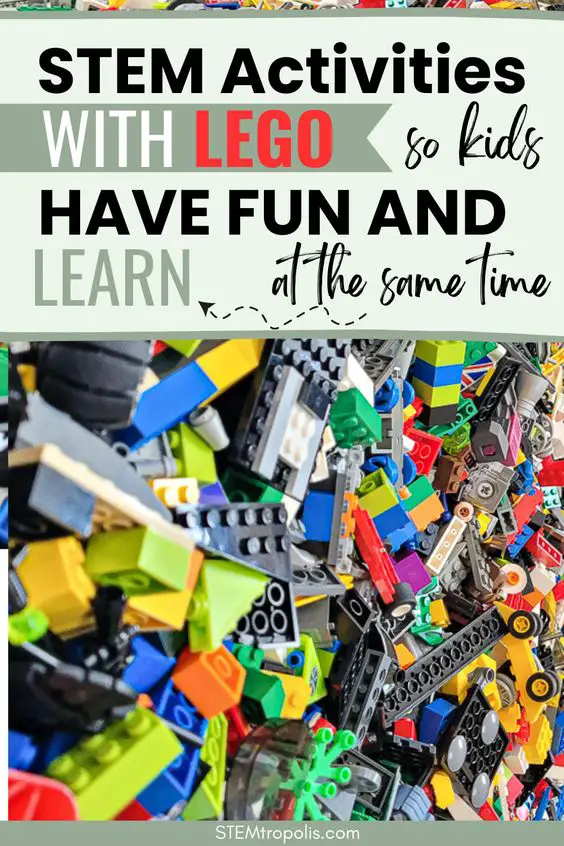
Wrap Up – STEM and STEAM Activities with LEGO
With just a few LEGO pieces, you can create a fun activity that teaches children essential science concepts.
By using LEGOs, children can explore concepts related to Science, Technology, Engineering, and Mathematics (STEM) while also developing important skills such as creativity, problem-solving, and critical thinking.
In this article, we have compiled some of the best LEGO activity ideas for kids that are both fun and educational. These activities can be adapted for a range of age groups and skill levels, and can be done individually or as a group.
Can’t get enough LEGO? Read more about LEGO and STEM or check out some awesome LEGO machine builds. Also, find out what to do with your LEGOs after they’re built.

